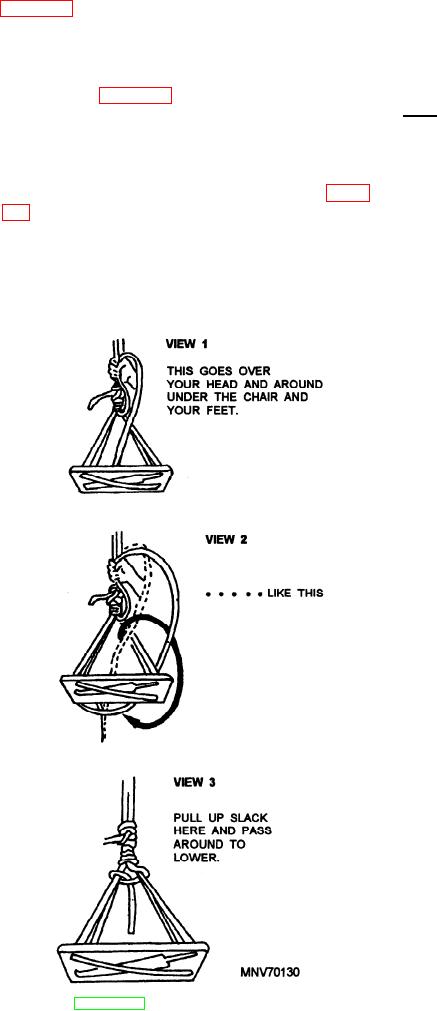
slack and pass it around. Before you go aloft for the first
Now the strain is on the bridle, as in the first view of
time, practice hanging off deck a few times.
With your free left hand, pull up some slack from
SAFETY PRECAUTIONS
below so you will have enough line to pass over your
head, around the chair, and under your feet, as in the
The following are a few safety precautions you
second view of figure 5-6. This maneuver is a bit tricky,
must follow whenever you work aloft. Before you go
especially if you have a bucket or two hanging on the
aloft, review all of the safety precautions on working
chair, but you will not have any trouble if you have
aloft listed in OPNAV Instruction 5100, Vol II,
enough slack pulled up. Keep hold of the gantline with
Chapter 8.
your right hand until you have worked the hitch up to the
apex of the bridle, as shown in the third view of figure
1. Be sure you have permission from the officer of
5-6. Then hold the two parts of the gantline above your
the deck (OOD) before you go aloft.
right hand with your left, and work the rest of the slack
2. Be sure that radio and radar units are OFF and
down.
rotatable antennas are stopped and guarded. Ask if the
You are now in no danger of falling, and all you
"man aloft chit" has been completed. A man aloft chit is
have to do to lower the boatswain's chair is pull up the
processed to ensure that key personnel are aware of any
work being done aloft. The chit is signed by the ship's
electrical maintenance officer (EMO), communications
officer (COMMO), and command duty officer
(CDO).
3. Tie your tools and equipment to the boatswain's
chair to prevent them from falling on personnel
below.
4. Wear a safety harness and secure it to a fixed
object above you once you are aloft.
WORKING OVER THE
SIDE
As with work aloft, work over the side has certain
rules that the must be followed. The following rules are
the basic rules for all work over the side.
1. Personnel preparing to work over the side
should notify the OOD. Upon securing, they should
notify the OOD again.
2. All personnel working over the side of the ship
on stages, boatswain's chairs, and on work floats or
boats along the side of the ship must wear life jackets
and, with the exception of personnel in boats, must be
equipped with a parachute-type safety harness with
safety lines tended from the deck above.
3. All personnel should be instructed in all
applicable safety regulations before they are permitted
to work over the side of the ship on scaffolding, stages,
or in boatswains' chairs.
4. A competent petty officer must constantly
supervise personnel working on scaffolding, stages, and
in boatswains' chairs, and personnel must be assigned to
tend the safety lines.
Figure 5-6.--Rigging for self-lowering.
5-4

